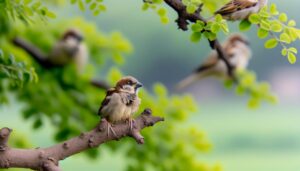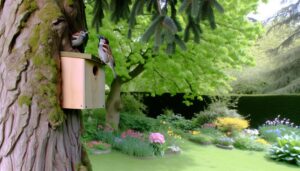10 Key Differences Between House Sparrow Eggs vs Wren Eggs
House sparrow eggs are larger, measuring 20-22 mm in length, compared to wren eggs at 12-18 mm. Sparrows' eggs exhibit pale blue to greenish hues with speckling, while wren eggs are white or light pink with reddish-brown spots.
House sparrows nest in urban environments using man-made structures, whereas wrens prefer tree cavities and shrubbery. House sparrow eggs incubate for 10-14 days with shared parental roles, while wren eggs take 12-16 days, mainly incubated by females.
Diverse nesting preferences, different parental strategies, and environmental adaptability affect their offspring's survival. Understanding these distinctions can provide deeper insights into avian reproductive ecology.

Key Takeaways
- House sparrow eggs are larger (20-22 mm) compared to wren eggs (12-18 mm).
- House sparrow eggs have a pale blue to greenish hue with speckling, while wren eggs are white or light pink with reddish-brown spots.
- House sparrows nest in urban areas using man-made structures, whereas wrens prefer natural sites like tree cavities.
- House sparrow eggs have a 10-14 day incubation period with both parents involved, while wren eggs incubate for 12-16 days with mostly female involvement.
- House sparrows have larger clutch sizes and higher adaptability, whereas wrens have smaller clutches with more parental care and better nest concealment.
Egg Size Comparison
When comparing the egg size of house sparrows (Passer domesticus) to that of wrens (Troglodytidae family), it is evident that house sparrow eggs are generally larger in both length and diameter. House sparrow eggs typically measure around 20-22 millimeters in length and 15-16 millimeters in diameter, whereas wren eggs are smaller, averaging 12-18 millimeters in length and 10-13 millimeters in diameter.
This size discrepancy can be attributed to differences in species' reproductive strategies and ecological niches. Larger eggs often correlate with higher energy investment per offspring, potentially increasing survival rates. Conversely, smaller eggs might allow for larger clutch sizes, enhancing reproductive success through quantity.
These dimensions reflect the evolutionary adaptations of each species to their respective environments.
Color and Pattern Differences
Examining the color and pattern differences between House-Sparrow and Wren eggs reveals distinct characteristics in eggshell color variations and speckling patterns.
House-Sparrow eggs typically exhibit a range of pale blue to greenish hues, often adorned with fine speckling.
In contrast, Wren eggs are generally white or light pink, frequently marked with reddish-brown spots concentrated at the larger end.
Eggshell Color Variations
The eggshell color variations between house sparrows and wrens exhibit distinct differences in both hue and pattern, providing valuable insights into their respective reproductive strategies and environmental adaptations.
House sparrow eggs typically present a light, creamy white to pale gray base color, which may vary slightly depending on environmental factors. In contrast, wren eggs often display a more varied palette, ranging from white to pale pink or buff.
These color variations are believed to be adaptive, offering camouflage against predation and optimizing thermal regulation. The differences in eggshell coloration between these two species underscore their unique ecological niches and evolutionary pressures, reflecting the intricate balance between visibility, protection, and temperature maintenance within their respective habitats.
Speckling and Markings
House sparrow eggs exhibit a consistent pattern of fine speckling, usually in shades of brown or gray, whereas wren eggs display a more irregular and diverse array of markings, ranging from dense speckles to blotches in varying hues of red, brown, and purple.
The uniformity in house sparrow eggs suggests adaptation for camouflage in their nesting environments, which often include cavities or dense foliage. In contrast, the variability in wren eggs may reflect a broader range of nesting sites and a strategy to reduce predation through unpredictable patterning.
This distinction in speckling and markings underscores the evolutionary pressures and ecological niches that shape the reproductive strategies of these avian species, emphasizing their distinct approaches to survival and reproduction.
Nesting Locations
House sparrows and wrens exhibit distinct preferences in their nesting locations, influenced by their specific habitat choices and nesting site preferences.
House sparrows typically favor urban and suburban environments, often nesting in man-made structures such as eaves and crevices.
In contrast, wrens are more likely to select natural sites like tree cavities and dense shrubbery, reflecting their adaptation to a variety of woodland and garden habitats.
Preferred Habitat Choices
Despite their shared environments, house sparrows and wrens exhibit distinct preferences in their nesting locations, which reflect their unique ecological adaptations and behavioral strategies.
House sparrows (Passer domesticus) typically favor urban and suburban areas, often utilizing man-made structures such as eaves, roof cavities, and streetlights to establish their nests. This choice is driven by the abundance of food resources and reduced predation in human habitats.
In contrast, wrens (Troglodytes troglodytes) prefer more natural settings, such as dense shrubbery, tree cavities, and overgrown gardens. Their inclination towards secluded and vegetative areas provides optimal protection and camouflage against predators.
These divergent habitat choices underscore the species-specific survival tactics that house sparrows and wrens have evolved to maximize reproductive success.
Nesting Site Preferences
Although both species adapt to varying environments, their nesting site preferences reveal distinct ecological behaviors and strategies that enhance their reproductive success.
House sparrows (Passer domesticus) typically select urban and suburban settings, utilizing cavities in buildings, eaves, and other man-made structures. This choice capitalizes on human-altered landscapes, providing ample protection and proximity to food sources.
Conversely, wrens (Troglodytes troglodytes) favor natural and semi-natural habitats, such as dense shrubs, tree hollows, and tangled vegetation. These choices reflect a preference for concealment and reduced predation risk. The wrens' selection of more secluded and vegetative sites enhances offspring survival by mitigating exposure to predators and environmental stressors.
Therefore, each species' nesting site preferences are emblematic of their adaptive strategies to their respective environments.
Incubation Periods
The incubation period for house sparrow eggs typically ranges from 10 to 14 days. Wren eggs, on the other hand, generally require a slightly longer period of 12 to 16 days, reflecting species-specific reproductive strategies.
This variation in incubation durations can be attributed to differences in embryonic development rates and environmental adaptations.
House sparrows, often nesting in urban environments, benefit from a shorter incubation period that minimizes exposure to potential threats. Wrens, frequently found in more secluded habitats, compensate with a longer incubation period, potentially resulting in more robust fledglings.
These incubation periods are critical as they influence the timing of hatching, subsequent feeding demands, and overall survival rates. Understanding these differences enhances our comprehension of avian reproductive ecology.
Parental Roles
Understanding the incubation periods lays the groundwork for examining the distinct parental roles exhibited by house sparrows and wrens during the nesting phase.
In house sparrows, both male and female participate in incubating the eggs and feeding the hatchlings, demonstrating a cooperative approach. The males often guard the nest, ensuring protection from potential predators.
Conversely, wrens exhibit a more divided parental role; the female primarily incubates the eggs and takes the lead in nurturing the young. The male wren, however, contributes by constructing multiple nests within their territory to increase reproductive success, sometimes assisting with feeding.
These differing roles reflect varying evolutionary strategies, tailored to optimize the survival and development of their offspring in their respective ecological niches.
Survival Rates
Analyzing the survival rates of house sparrow and wren offspring reveals significant differences influenced by their distinct parental strategies and environmental adaptations.
House sparrows (Passer domesticus) exhibit higher fledgling survival rates, attributed to their aggressive defense mechanisms and ability to thrive in diverse habitats. These birds lay more eggs per clutch, compensating for potential predation and environmental challenges.
In contrast, wrens (Troglodytes troglodytes) often have lower survival rates due to their smaller clutch sizes and specialized nesting sites, which may be more susceptible to environmental fluctuations. Additionally, wrens invest heavily in nest concealment and parental care, which, while reducing predation risk, may limit their adaptability to rapidly changing habitats.
Consequently, these species exemplify varied reproductive strategies impacting offspring survival.
Conclusion
To conclude, the comparative analysis between house sparrow and wren eggs reveals significant differences in egg size, coloration, and patterns.
Nesting locations vary, with sparrows preferring cavities and wrens favoring dense shrubs.
Incubation periods differ, with sparrows requiring approximately 11-14 days and wrens about 12-15 days.
Parental roles exhibit distinct behaviors, with both species sharing incubation duties.
Survival rates are influenced by environmental factors and predation risks, underscoring the adaptive strategies employed by each species for reproductive success.






